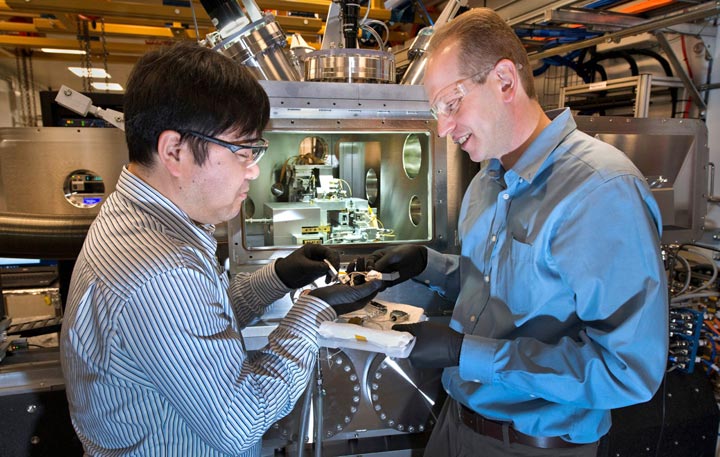A New X-Ray Microscope for Nanoscale Imaging
April 10, 2015

Yong Chu and Evgeny Nazaretski work in front of the new microscope they designed and installed at the NSLS-II.
Delivering the capability to image nanostructures and chemical reactions down to nanometer resolution requires a new class of x-ray microscope that can perform precision microscopy experiments using ultra-bright x-rays from the National Synchrotron Light Source II (NSLS-II) at the U.S. Department of Energy’s Brookhaven National Laboratory. This groundbreaking instrument, designed to deliver a suite of unprecedented x-ray imaging capabilities for the Hard X-ray Nanoprobe (HXN) beamline, brings researchers one step closer to the ultimate goal of nanometer resolution at NSLS-II.
The microscope manipulates novel nanofocusing optics called multilayer Laue lenses (MLL) — incredibly precise lenses grown one atomic layer at a time — which produce a tiny x-ray beam that is currently about 10 nanometers in size. Focusing an x-ray beam to that level means being able to see the structures on that length scale; whether they are proteins in a biological sample, or the inner workings of a fuel cell catalyst.
The team of scientists who built this microscope aren’t stopping there; they are working toward making the focused x-ray beam spot even smaller in the future. The microscope they developed produces x-ray images by scanning a sample while collecting various x-ray signals emerging from the sample. Analysis of these signals helps researchers understand crucial information about the materials they are examining: density, elemental composition, chemical state, and the crystalline structure of the sample.
“This instrument is a critical link connecting NSLS-II’s bright x-rays to unprecedented nanoscale x-ray imaging capabilities, which we believe will lead to many groundbreaking scientific discoveries”, stressed Yong Chu, the group leader of the Hard X-ray Nanoprobe Beamline at NSLS-II. The HXN beamline and the HXN x-ray microscope are currently being commissioned and will be available for user experiments later this year.
To learn more visit: www.bnl.gov/newsroom/news.php?a=25398
2015-5639 | INT/EXT | Newsroom









